Towards Explainable Deep Neural Networks for the Automatic Detection of Diabetic Retinopathy
Abstract
Featured Application
Abstract
1. Introduction
- Evaluate three state-of-the-art deep transfer learning algorithm models using color fundus images for automatic DR detection;
- Optimize the proposed transfer learning deep learning architectures through early stopping and dropout techniques to control the models’ overfitting tendency.
- Perform Grad-CAM analysis to provide human-interpretable explanations of the deep architectures’ predictions of DR.
2. Materials and Methods
2.1. Dataset
2.2. CNN Models
2.2.1. Convolutional Neural Networks
2.2.2. Visual Geometry Group
2.2.3. The Residual Network
2.2.4. DenseNet-121
2.3. Models’ Explainability Using Grad-CAM
2.4. Performance Evaluation Metrics
- Accuracy: calculated as the percentage of the correctly classified images by:where N is the total number of images in the evaluated set, is the true positive, i.e., detected abnormal cases, and is the true negative, i.e., normal cases not detected as abnormal.
- Precision: calculated as the number of divided by the sum of and false positives, normal cases detected as abnormal.
- Sensitivity/Recall: calculated as the number of, divided by the sum of and false negatives , abnormal cases detected as normal:
- F1-Score: defined as the harmonic mean of precision and recall:
- Confusion matrix: A confusion matrix is a table used for summarizing a classifier’s performance. The number of correctly and incorrectly classified samples are summarized with count values and broken down by each category.
2.5. Proposed Explainability Evaluation Metric
3. Results
3.1. Model Performance on the Test Set
3.1.1. Binary Classification
3.1.2. Multiple Classification
3.2. Models Explainability on the Test Set
4. Discussion
5. Conclusions
Funding
Institutional Review Board Statement
Informed Consent Statement
Data Availability Statement
Acknowledgments
Conflicts of Interest
References
- Arcadu, F.; Benmansour, F.; Maunz, A.; Willis, J.; Haskova, Z.; Prunotto, M. Deep learning algorithm predicts diabetic retinopathy progression in individual patients. NPJ Digit. Med. 2019, 2, 92. [Google Scholar] [CrossRef]
- WHO. Diabetes. 2021. Available online: https://www.who.int/news-room/fact-sheets/detail/diabetes (accessed on 16 July 2021).
- Retinopathy, D.; Understanding, D. Diabetic Retinopathy—Epidemiology Forecast to 2029. 2021, pp. 1–5. Available online: https://www.reportlinker.com/p05961707/Diabetic-Retinopathy-Epidemiology-Forecast-to.html?utm_source=GNW (accessed on 26 August 2022).
- Abràmoff, M.D.; Reinhardt, J.M.; Russell, S.R.; Folk, J.C.; Mahajan, V.B.; Niemeijer, M.; Quellec, G. Automated Early Detection of Diabetic Retinopathy. Ophthalmology 2010, 117, 1147–1154. [Google Scholar] [CrossRef]
- Chowdhury, A.R.; Chatterjee, T.; Banerjee, S. A Random Forest Classifier-Based Approach in the Detection of Abnormalities in the Retina. Med. Biol. Eng. Comput. 2019, 57, 193–203. [Google Scholar] [CrossRef] [PubMed]
- Bourouis, S.; Zaguia, A.; Bouguila, N.; Alroobaea, R. Deriving Probabilistic SVM Kernels from Flexible Statistical Mixture Models and its Application to Retinal Images Classification. IEEE Access 2019, 7, 1107–1117. [Google Scholar] [CrossRef]
- Emon, M.U.; Zannat, R.; Khatun, T.; Rahman, M.; Keya, M.S. Performance Analysis of Diabetic Retinopathy Prediction using Machine Learning Models. In Proceedings of the 2021 6th International Conference on Inventive Computation Technologies (ICICT), Coimbatore, India, 20–22 January 2021; pp. 1048–1052. [Google Scholar] [CrossRef]
- Zhou, J.; Gandomi, A.H.; Chen, F.; Holzinger, A. Evaluating the quality of machine learning explanations: A survey on methods and metrics. Electronics 2021, 10, 593. [Google Scholar] [CrossRef]
- Anoop, B.K. Binary Classification of DR-Diabetic Retinopathy using CNN with Fundus Colour Images. Mater. Today Proc. 2022, 58, 212–216. [Google Scholar] [CrossRef]
- Pires, R.; Avila, S.; Wainer, J.; Valle, E.; Abramoff, M.D.; Rocha, A. A data-driven approach to referable diabetic retinopathy detection. Artif. Intell. Med. 2019, 96, 93–106. [Google Scholar] [CrossRef] [PubMed]
- Dataset, K. Diabetic Retinopathy Detection. 2015. Available online: https://www.kaggle.com/c/diabetic-retinopathy-detection (accessed on 30 May 2022).
- Decencière, E.; Zhang, X.; Cazuguel, G.; Lay, B.; Cochener, B.; Trone, C.; Gain, P.; Ordonez, R.; Massin, P.; Erginay, A.; et al. Feedback on a publicly distributed database: The Messidor database. Image Anal. Stereol. 2014, 33, 231–234. [Google Scholar] [CrossRef]
- Wan, S.; Liang, Y.; Zhang, Y. Deep convolutional neural networks for diabetic retinopathy detection by image classification. Comput. Electr. Eng. 2018, 72, 274–282. [Google Scholar] [CrossRef]
- Sarki, R.; Michalska, S.; Ahmed, K.; Wang, H.; Zhang, Y. Convolutional neural networks for mild diabetic retinopathy detection: An experimental study. bioRxiv 2019, 763136. [Google Scholar] [CrossRef]
- Hagos, M.T.; Kant, S. Transfer Learning based Detection of Diabetic Retinopathy from Small Dataset. 2019. Available online: http://arxiv.org/abs/1905.07203 (accessed on 26 August 2022).
- Chatpatanasiri, R. APTOS: Eye Preprocessing in Diabetic Retinopathy. 2019. Available online: https://www.kaggle.com/ratthachat/aptos-eye-preprocessing-in-diabetic-retinopathy (accessed on 26 August 2022).
- Russakovsky, O.; Deng, J.; Su, H.; Krause, J.; Satheesh, S.; Ma, S.; Huang, Z.; Karpathy, A.; Khosla, A.; Bernstein, M.; et al. “ImageNet Large Scale Visual Recognition Challenge. Int. J. Comput. Vis. 2015, 115, 211–252. [Google Scholar] [CrossRef]
- Simonyan, K.; Zisserman, A. Very deep convolutional networks for large-scale image recognition. In Proceedings of the 3rd International Conference on Learning Representations, Conference Track Proceedings, San Diego, CA, USA, 7–9 May 2015; pp. 1–14. [Google Scholar]
- He, K.; Zhang, X.; Ren, S.; Sun, J. Deep residual learning for image recognition. In Proceedings of the IEEE Conference on Computer Vision and Pattern Recognition, Las Vegas, NV, USA, 27–30 June 2016; pp. 770–778. [Google Scholar] [CrossRef]
- Huang, G.; Liu, Z.; van der Maaten, L.; Weinberger, K.Q. Densely connected convolutional networks. In Proceedings of the 30th IEEE Conference on Computer Vision and Pattern Recognition, Honolulu, HI, USA, 21–26 July 2017; pp. 2261–2269. [Google Scholar] [CrossRef]
- Zhou, B.; Khosla, A.; Lapedriza, A.; Oliva, A.; Torralba, A. Learning Deep Features for Discriminative Localization. In Proceedings of the IEEE Conference on Computer Vision and Pattern Recognition, Las Vegas, NV, USA, 27–30 June 2016; pp. 2921–2929. [Google Scholar] [CrossRef]
- Zhou, B.; Khosla, A.; Lapedriza, A.; Oliva, A.; Torralba, A. Object detectors emerge in deep scene CNNs. In Proceedings of the 3rd International Conference on Learning Representations, Conference Track Proceedings, San Diego, CA, USA, 7–9 May 2015. [Google Scholar]
- Selvaraju, R.R.; Cogswell, M.; Das, A.; Vedantam, R.; Parikh, D.; Batra, D. Grad-CAM: Visual Explanations from Deep Networks via Gradient-Based Localization. Int. J. Comput. Vis. 2020, 128, 336–359. [Google Scholar] [CrossRef]
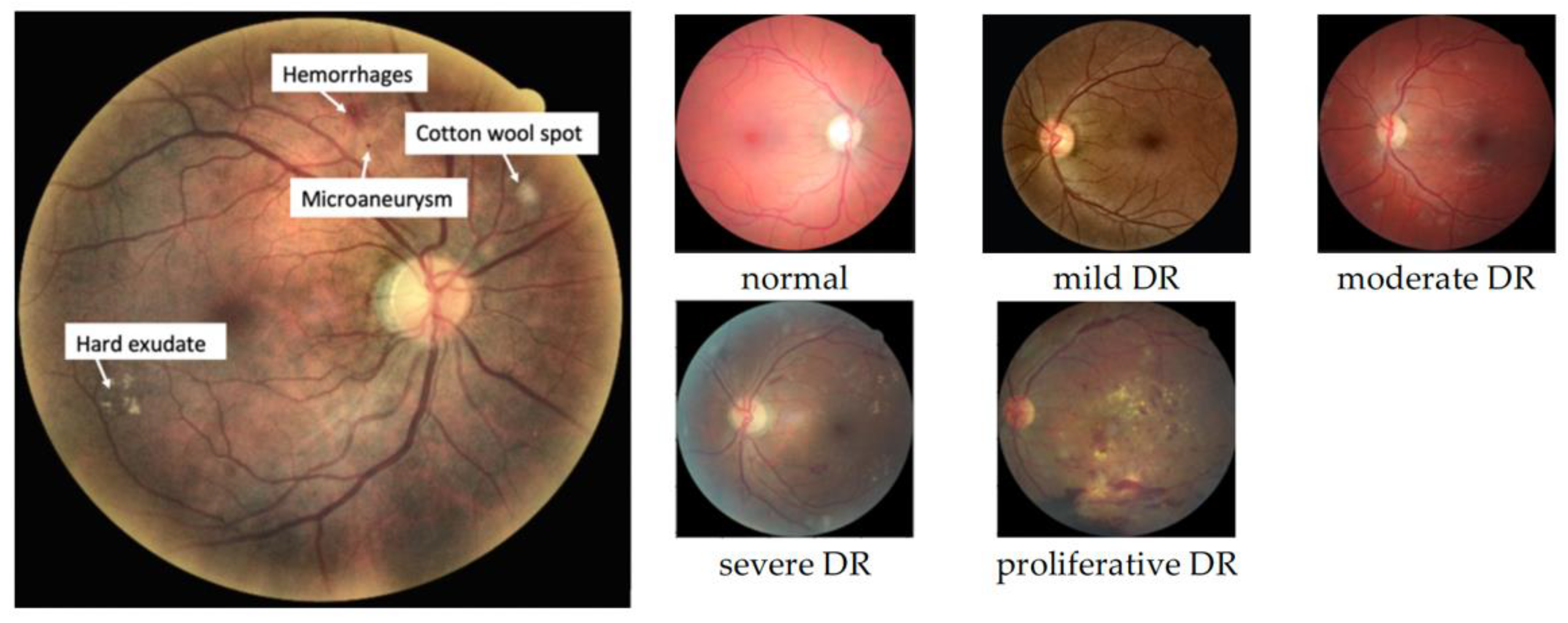
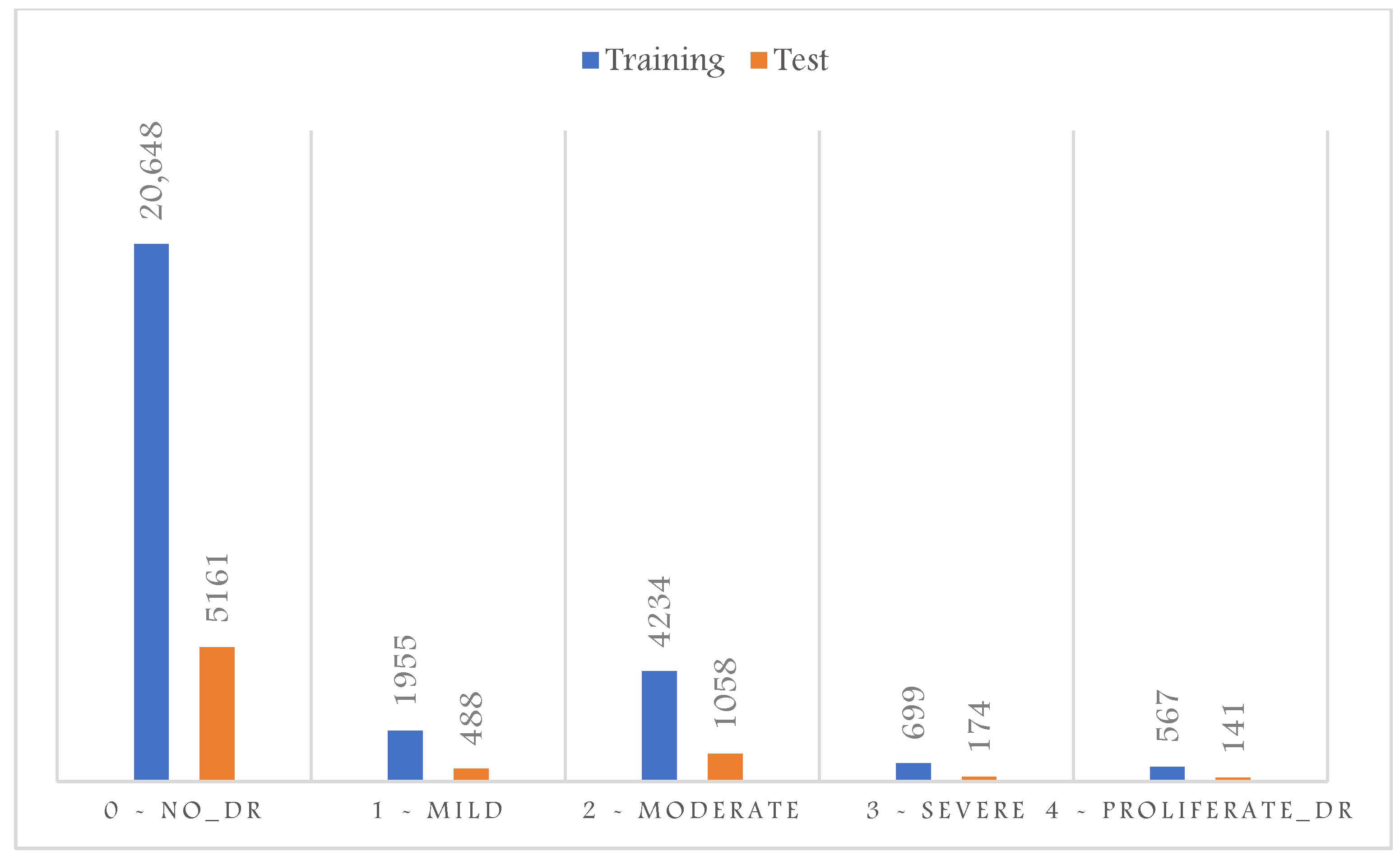
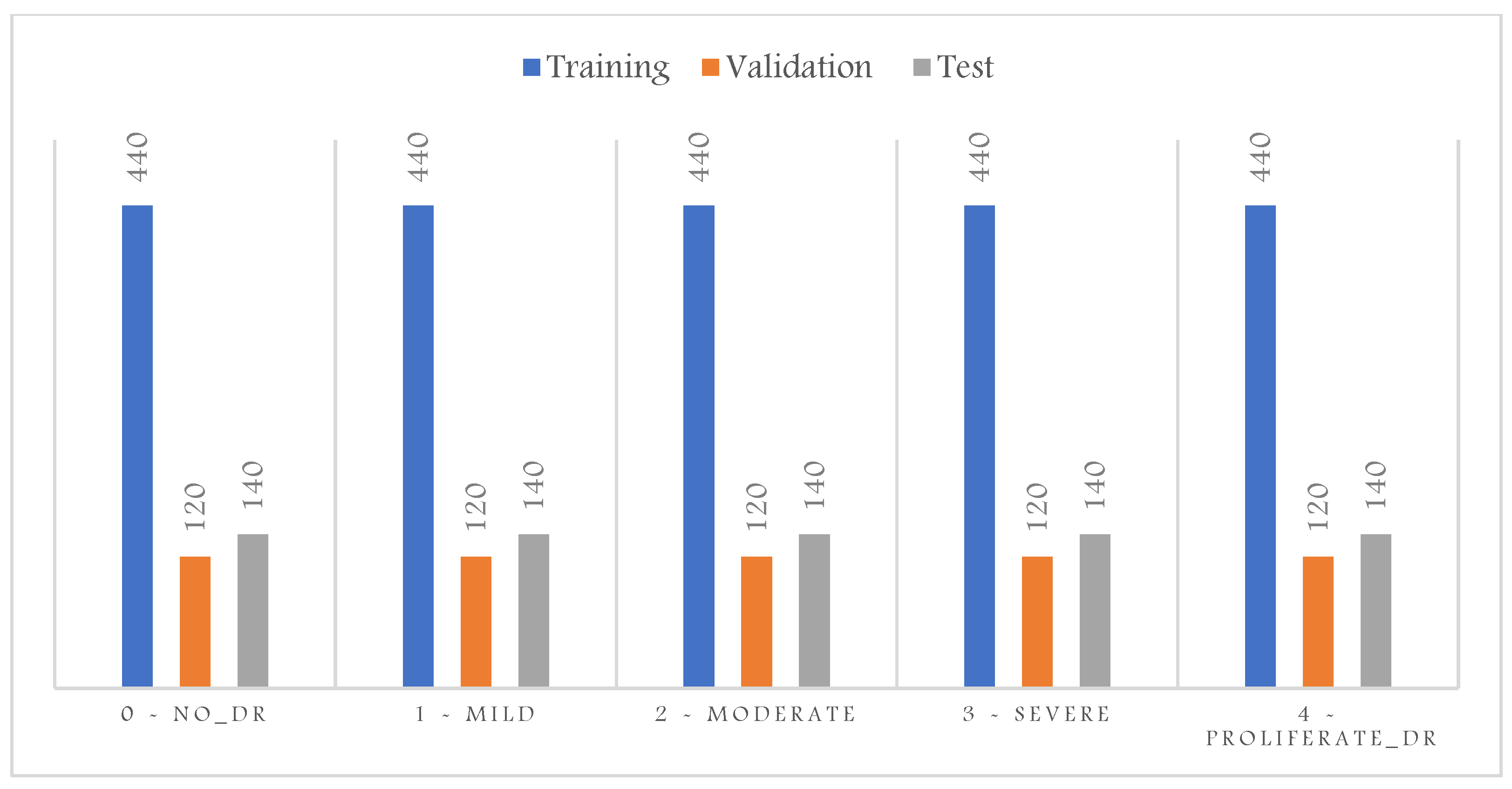

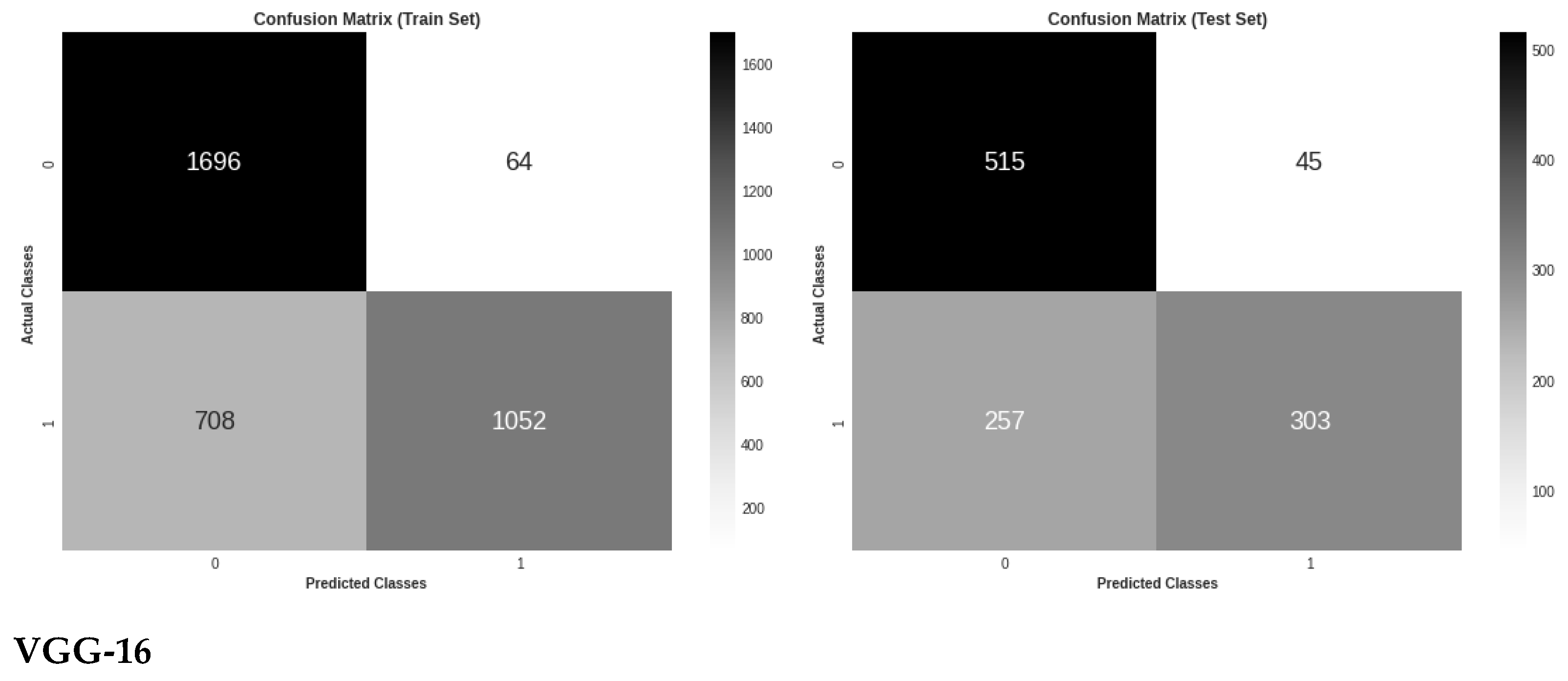
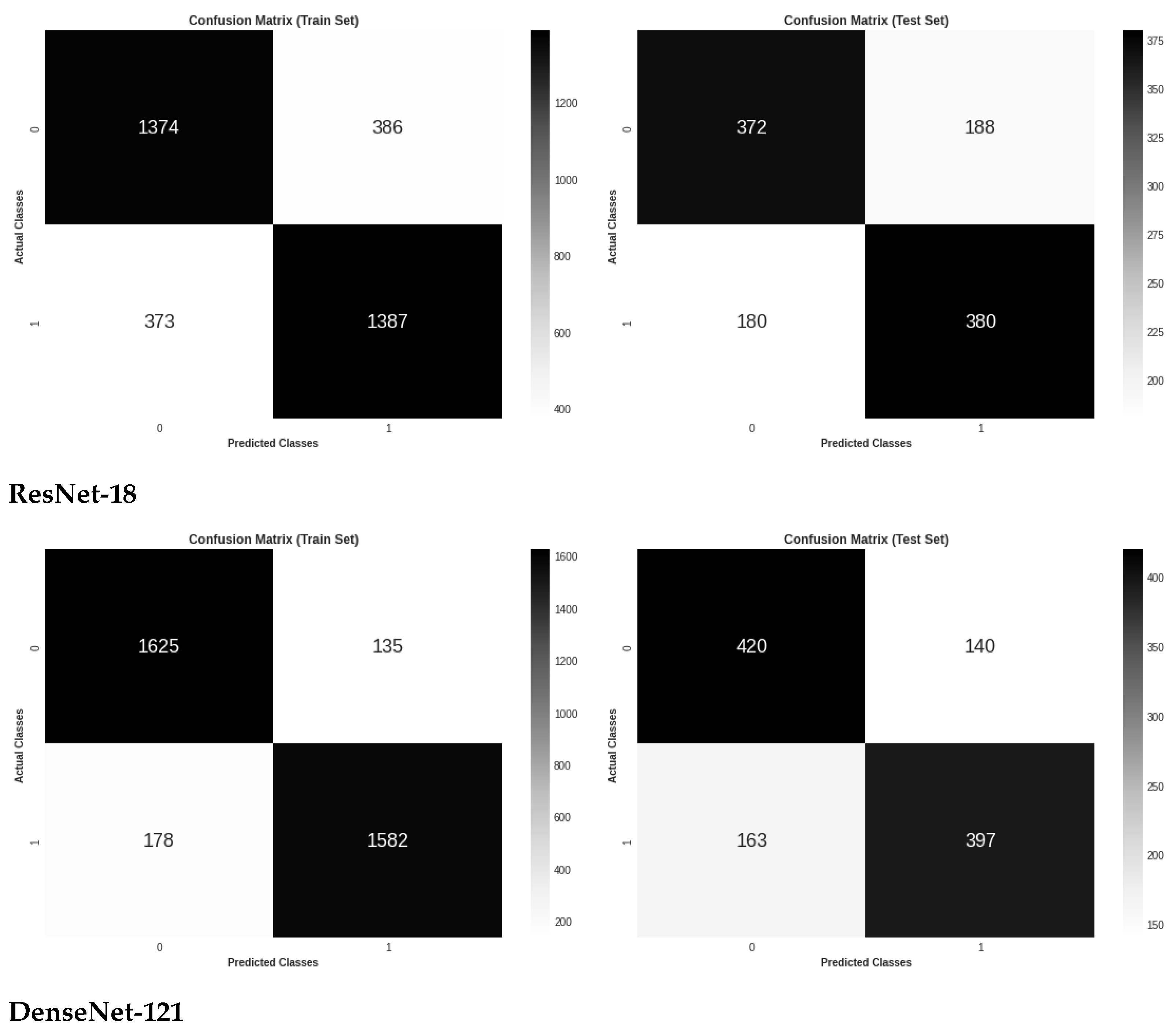
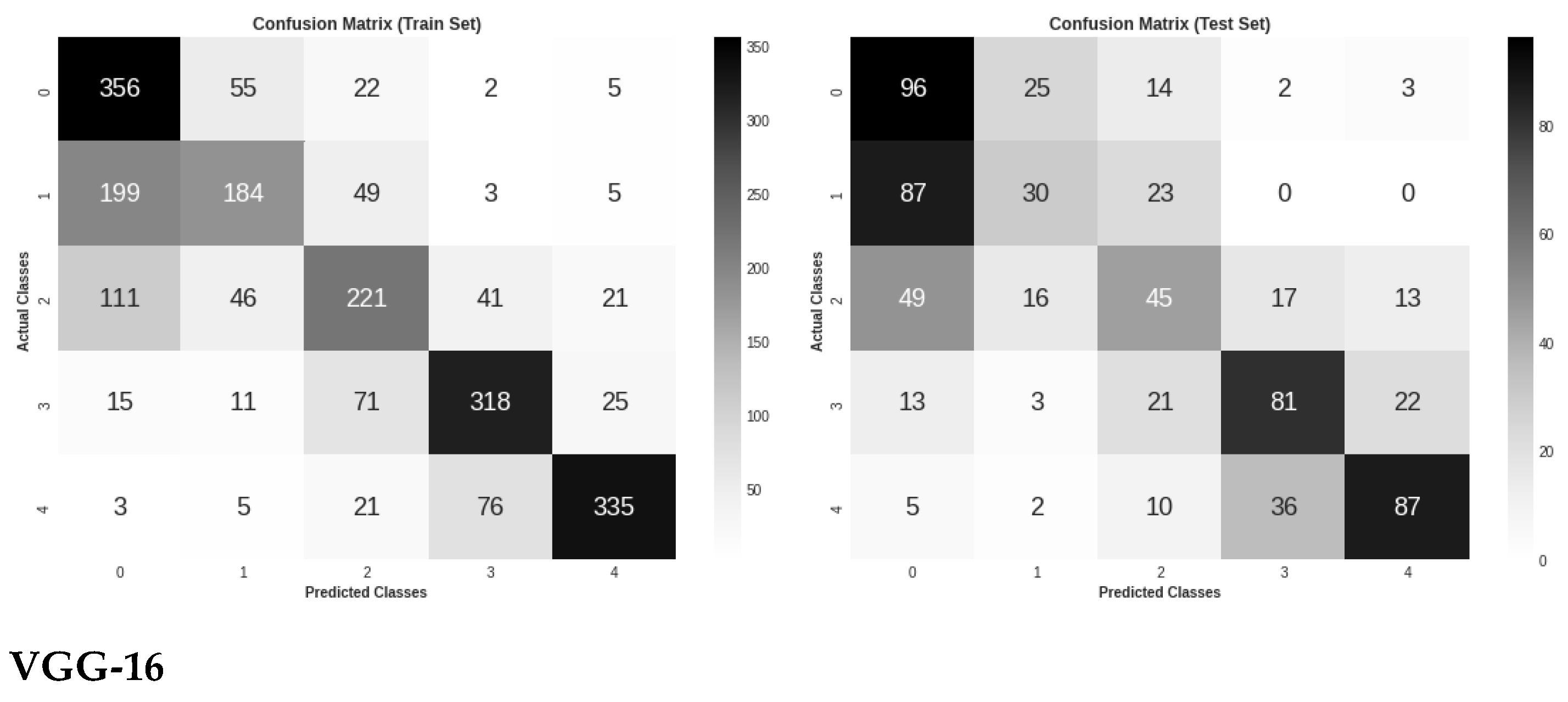
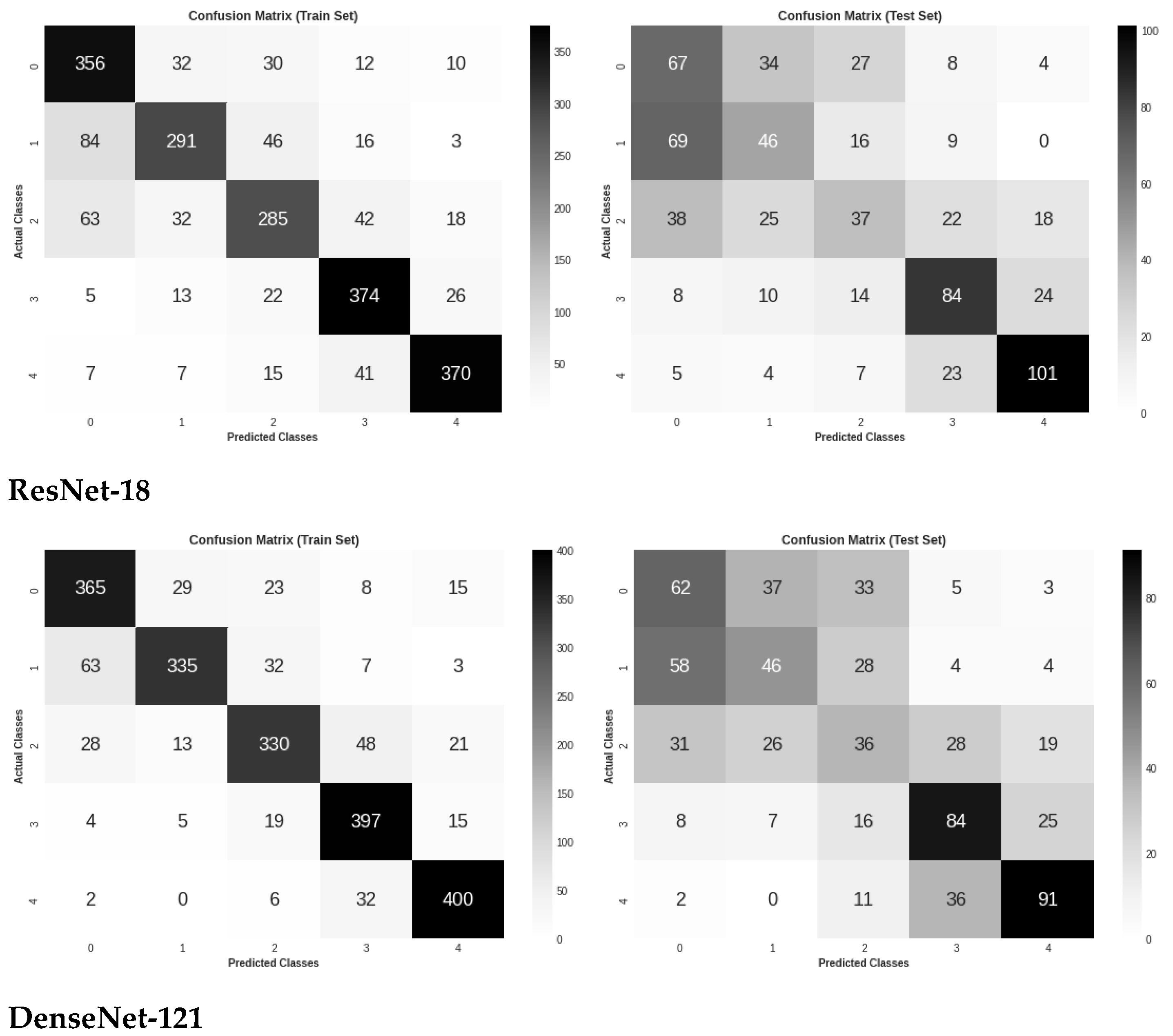
| Reference | Dataset | Approach | Accuracy |
|---|---|---|---|
| [5] | DIARETDB1 | Random Forest | 93.58% |
| [6] | Public DR datasets | SVM with Bhattacharyya kernel | 91.33% |
| [7] | Messidor | Logistic Regression | 75.00% |
| [10] | Kaggle DR dataset, Messidor-2 | CNN | 98.20% |
| [13] | Kaggle DR dataset | AlexNet, VggNet, GoogleNet, and ResNet | 95.68% |
| [14] | Kaggle DR dataset | ResNet50, Xception Nets, DenseNets, and VGG | 81.30% |
| [15] | Kaggle DR dataset | Inception-V3 | 90.90% |
| Model | Precision 1 | Recall 1 | F1-Score 1 | Train Accuracy | Test Accuracy |
|---|---|---|---|---|---|
| VGG16 | 0.87 | 0.52 | 0.65 | 78.07% | 73.04% |
| ResNet-18 | 0.67 | 0.68 | 0.67 | 78.44% | 67.14% |
| DenseNet-121 | 0.74 | 0.71 | 0.73 | 91.11% | 72.95% |
| Model | Precision 1 | Recall 1 | F1-Score 1 | Train Accuracy | Test Accuracy |
|---|---|---|---|---|---|
| VGG16 | 0.45 | 0.48 | 0.47 | 64.27% | 48.43% |
| ResNet-18 | 0.44 | 0.48 | 0.46 | 76.18% | 47.86% |
| DenseNet-121 | 0.42 | 0.46 | 0.44 | 83.05% | 45.57% |
| Original Image | VGG16 | ResNet-18 | DenseNet-121 |
|---|---|---|---|
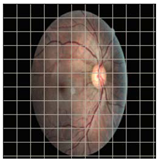 | 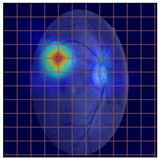 | 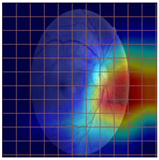 | 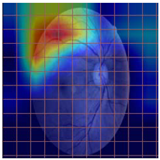 |
| (a) | |||
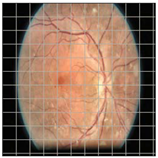 | 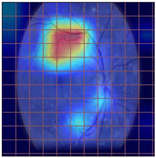 | 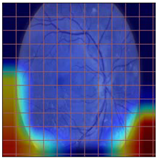 | 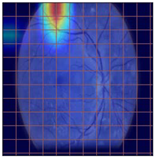 |
| (b) | |||
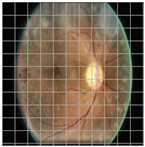 | 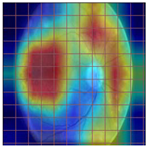 | 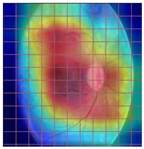 | 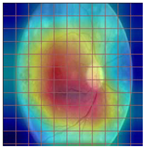 |
| (c) | |||
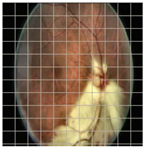 | 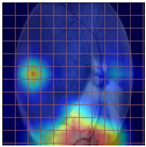 | 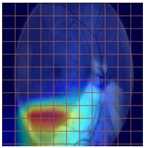 | 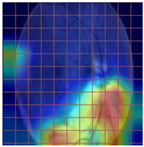 |
| (d) | |||
| Model | Conformity with Normal Retinal Photos | Conformity with Abnormal Retinal Photos | Average Conformity |
|---|---|---|---|
| VGG16 | 0.2000 | 0.2414 | 0.2207 |
| ResNet-18 | 0.0294 | 0.0645 | 0.0469 |
| DenseNet-121 | 0.0385 | 0.0286 | 0.0336 |
Publisher’s Note: MDPI stays neutral with regard to jurisdictional claims in published maps and institutional affiliations. |
© 2022 by the author. Licensee MDPI, Basel, Switzerland. This article is an open access article distributed under the terms and conditions of the Creative Commons Attribution (CC BY) license (https://creativecommons.org/licenses/by/4.0/).
Share and Cite
Alghamdi, H.S. Towards Explainable Deep Neural Networks for the Automatic Detection of Diabetic Retinopathy. Appl. Sci. 2022, 12, 9435. https://doi.org/10.3390/app12199435
Alghamdi HS. Towards Explainable Deep Neural Networks for the Automatic Detection of Diabetic Retinopathy. Applied Sciences. 2022; 12(19):9435. https://doi.org/10.3390/app12199435
Chicago/Turabian StyleAlghamdi, Hanan Saleh. 2022. "Towards Explainable Deep Neural Networks for the Automatic Detection of Diabetic Retinopathy" Applied Sciences 12, no. 19: 9435. https://doi.org/10.3390/app12199435
APA StyleAlghamdi, H. S. (2022). Towards Explainable Deep Neural Networks for the Automatic Detection of Diabetic Retinopathy. Applied Sciences, 12(19), 9435. https://doi.org/10.3390/app12199435






